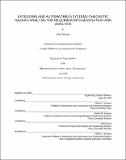Extending and automating a systems-theoretic hazard analysis for requirements generation and analysis
Author(s)
Thomas, John P., IV
DownloadFull printable version (3.885Mb)
Other Contributors
Massachusetts Institute of Technology. Engineering Systems Division.
Advisor
Nancy. G. Leveson.
Terms of use
Metadata
Show full item recordAbstract
Systems Theoretic Process Analysis (STPA) is a powerful new hazard analysis method designed to go beyond traditional safety techniques-such as Fault Tree Analysis (FTA)-that overlook important causes of accidents like flawed requirements, dysfunctional component interactions, and software errors. Although traditional techniques have been effective at analyzing and reducing accidents caused by component failures, modem complex systems have introduced new problems that can be much more difficult to anticipate, analyze, and prevent. In addition, a new class of accidents, component interaction accidents, has become increasingly prevalent in today's complex systems and can occur even when systems operate exactly as designed and without any component failures. While STPA has proven to be effective at addressing these problems, its application thus far has been ad-hoc with no rigorous procedures or model-based design tools to guide the analysis. In addition, although no formal structure has yet been defined for STPA, the process is based on a control-theoretic framework that could be formalized and adapted to facilitate development of automated methods that assist in analyzing complex systems. This dissertation defines a formal mathematical structure underlying STPA and introduces a procedure for systematically performing an STPA analysis based on that structure. A method for using the results of the hazard analysis to generate formal safety-critical, model-based system and software requirements is also presented. Techniques to automate both the STPA analysis and the requirements generation are introduced, as well as a method to detect conflicts between safety requirements and other functional model-based requirements during early development of the system.
Description
Thesis (Ph. D.)--Massachusetts Institute of Technology, Engineering Systems Division, 2013. Cataloged from PDF version of thesis. Includes bibliographical references (p. 223-232).
Date issued
2013Department
Massachusetts Institute of Technology. Engineering Systems DivisionPublisher
Massachusetts Institute of Technology
Keywords
Engineering Systems Division.